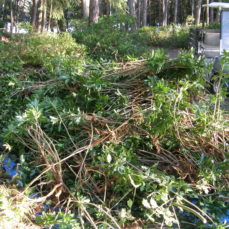
Photo credit: King County
Management Category
Squamish
Whistler
Pemberton
Vectors of Spread
Synonyms
Spurge laurel is also known as daphne laurel.
ID Characteristics
Spurge laurel is a long-lived evergreen shrub.
Flowers: Small clusters of pale green-yellow flowers, each with 4 cylindrical, spreading lobes. They lack corollas.
Stems: Mature stems are 0.5 – 1.8 m tall and have yellow-grey bark. Immature stems are green. Stems emit a strong odour when cut. The topmost stem section has leaves.
Leaves: Evergreen, bushy shrub with alternating oval leaves that taper at their base. Leaves are glossy, dark green, and 4 – 13 cm long.
Fruits: Flowers mature into green and then black, egg-shaped drupes (8 – 11 mm long). These fruits are highly poisonous.
Roots: Orange roots that flare out from the root collar.
CAUTION: All parts of spurge laurel are poisonous, and contain a sap that causes skin rashes and other symptoms (see impacts section, on p.2).
Similar Species
Invasive

Photo credit: John Ruter, University of Georgia, Bugwood.org
Cherry laurel (Prunus laurocerasus) is also an invasive plant, which has wider, finely-toothed leaves and long cylindrical inflorescences.
Exotic

Winter daphne (Daphne odora) has fragrant cream to purple flowers. Its berries are also poisonous.

Photo credit: World Plants
Choisya (Choisya ternata) produces white flowers, and its glossy leaves has 3 leaflets.
Native

Photo credit: Harlan B. Herbert, Bugwood.org
Pacific rhododendron (Rhododendron macrophyllum) has bright pink to purple flowers with leathery oblong leaves.
Habitat and Origin
Native to Europe, Southwestern Asia, Northern Africa, and the Mediterranean. Spurge laurel was introduced to BC as an ornamental.
Spurge laurel can be found in gardens, along roadsides and in moist wooded areas. It is shade tolerant, so it will grow in sunny or shaded areas, and thrives in well-drained soils, especially in forest understories. This plant does not require the soil to be disturbed for invasion.
How It Spreads
Spurge Laurel reproduces primarily by seed, but can also spread through root sprouts. Spurge Laurel plants begin producing seeds after 4 years of growth. Berries emerge shortly after the flowers bloom, and the seeds can produce new plants. The seeds are often spread by birds and rodents who eat the berries but can’t digest the seeds.
Spurge Laurel is also spread via the horticulture trade, as it is sometimes sold in nurseries for its attractive foliage.
Impacts
Ecological:
- Outcompetes native plants, spreading up to 5.5m per season, reducing biodiversity.
- Releases toxic chemicals (allelopathy) that inhibit germination of other plants.
- Grows through forest understories, spreads undetected via seeds dispersed by birds and rodents.
Health:
- All parts are highly toxic, causing rashes, nausea, swelling, and potentially coma.
- Ingestion can lead to severe symptoms: mouth burns, vomiting, bloody diarrhea, and coma.
- As few as 2-3 berries can be fatal to a child.
Economic:
- Reduces crop yields by crowding out forage fields, depleting moisture and nutrients.
Stop the Spread
Spurge laurel has been found in Lions Bay & Squamish. We aim to ERADICATE spurge laurel in the south of the Sea to Sky region, and PREVENT its spread to the north.
- Regularly monitor properties for weed infestations.
- Remove plant material from equipment, vehicles or clothing used in infested areas and wash equipment and vehicles at designated cleaning sites before leaving infested areas.
- Ensure soil and gravel are uncontaminated before transport.
- Minimize soil disturbances (e.g., use grazing plants that prevent soil exposure from overgrazing), and use seed mixes with dense, early colonization (e.g., alfalfa or barley) to re-vegetate exposed soil and resist invasion.
- Ensure invasive plants (particularly flowering heads or root fragments) are bagged or covered to prevent spread during transport to designated disposal sites (e.g., landfill). Do NOT compost.
Control
Caution: All parts of spurge laurel are poisonous, and contain a sap that causes skin rashes.
Mechanical Control:
- Wearing protective gear (waterproof gloves, rubber raincoat and pants, eye protection, and possibly a respirator), small spurge laurel plants may be hand-pulled.
- For larger plants, cut the stem below the root collar (which is located below the surface of the soil); it is safer not to dig up mature plants.
- Plant material must be bagged and taken to a landfill (DO NOT COMPOST).
- Monitor area for any new seedlings and cover with deep mulch.
- See WorksafeBC for more information on how to protect yourself from spurge laurel.
Chemical Control:
- From bud to late blooming stage, plants may be spot-sprayed until leaves and stems are wet with a product containing triclopyr (in accordance with the conditions listed on the label).
- Note that there is potential to injure nearby broadleaf plants when using triclopyr.
- We recommend that any herbicide application be carried out by a person holding a valid BC Pesticide Applicator Certificate. Before selecting and applying herbicides, you must review and follow herbicide labels and application rates; municipal, regional, provincial and federal laws and regulations; species-specific treatment recommendations, and site-specific goals and objectives.
Biological Control:
There are currently no known biological agents for spurge laurel.
Sea to Sky Distribution
Spurge Laurel Factsheet
Having trouble viewing the factsheet? Don’t worry, all the information is included on this page. You can also contact us with any questions.
Additional Resources
References
- Coastal Invasive Species Council, Daphne / Spurge Laurel (Daphne laureola) Control in BC
- East Multnomah Soil and Water Conservation District, Spurge Laurel
- Electronic Atlas of the Flora of BC, Daphne laureola
- Fraser Valley Invasive Species Society, Spurge Laurel
- Invasive Species Council of BC, Daphne (Spurge-laurel)
- King County, Spurge laurel identification and control
- Pacific Northwest Pest Management Handbooks, Spurge laurel (Daphne laureola)
- Washington State Noxious Weed Control Board, Spurge Laurel
- Worksafe BC, Toxic Plant Warning: Severe Skin Irritation from Spurge Laurel (Daphne laureola)
- Metrovancouver, Spurge Laurel Factsheet
- Metrovancouver, Best Management Practices.





















